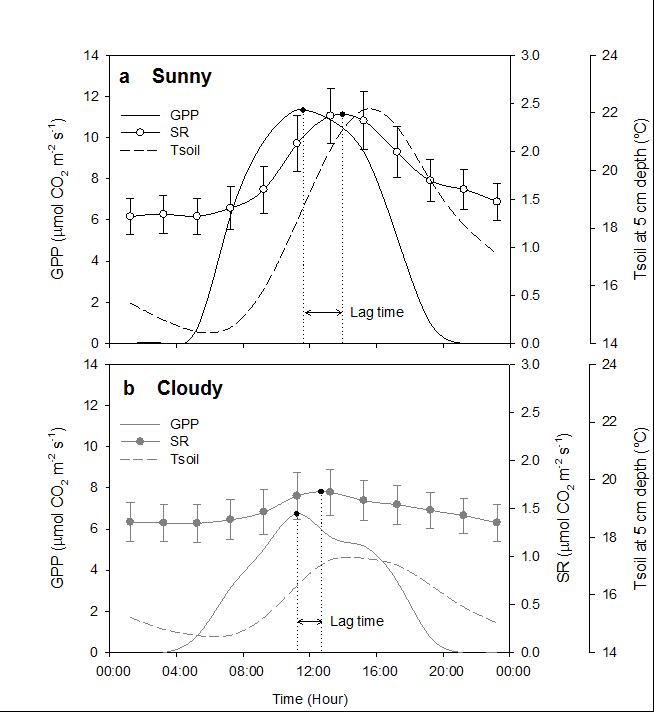| Research |
| Location:Home > Research > Research Progress |
| New Advances in Carbon Cycles and Carbon Budget of Coastal Wetlands |
Coastal wetlands, the interfaces between terrestrial and ocean ecosystems, play an important role in the global carbon cycle by acting as natural carbon sink. However, climate changes and human activities may accelerate the decomposition rates in some wetlands, causing them to become net source of CO2 to the atmosphere. Therefore, it is important to investigate the carbon budget and its controlling mechanisms over coastal wetland ecosystems for accurately evaluating global carbon budgets and scientifically managing wetland ecosystems. Based on the continuous observation in the Yellow River Delta Ecological Research Station of Coastal Wetland, Chinese Academy of Sciences, the typical processes in carbon cycles and carbon budget of coastal wetlands at different spatial scales have been systematically studied by YU Junbao’s group. The results were recently published in Soil Biology and Biochemistry, Agriculture, Ecosystems and Environment, Estuaries and Coasts. Although increasing evidence has provided that soil respiration is strongly related to recent canopy photosynthesis, doubts remain as to the extent to which primary productivity controls soil respiratory and the speed of the link between soil respiration and photosynthesis. Based on the automated measurements of soil respiration and eddy covariance measurements of ecosystem photosynthesis (i.e. gross primary production, GPP) in a coastal wetland, the group assessed the speed of link between ecosystem photosynthesis and soil respiration on the diurnal scale, and quantified the control of the ecosystem primary production on diurnal soil respiration. On the diurnal scale, the time of daily peak soil respiration lagged GPP but preceded soil temperature on both sunny and cloudy days. Daytime soil respiration was significantly linearly correlated with GPP with a lag of 1.5 h on sunny days and 1 h on cloudy days, respectively. By taking advantage of the natural shift of sunny and cloudy days without disturbance to the plant-soil system, the results also indicated that the changes in soil temperature and GPP together explained 53% of the changes in daytime soil respiration rates between sunny days and adjacent cloudy days. Thus, it is necessary to take into account the influence of photosynthesis on soil respiration in order to accurately simulate the magnitude and variation of soil respiration, especially at short and medium temporal scales (Han et al., 2014). Using the eddy covariance technique, we analyzed temporal variation in net ecosystem CO2 exchange (NEE) and determined the effects of environmental factors on the balance between ecosystemphotosynthesis and respiration in a reed (Phragmites australis) wetland in the Yellow River Delta, China (Han et al., 2013a). During the growing season of 2010, the cumulative CO2 emission was 1,657 g CO2 m−2, while 2,612 g CO2 m−2 was approximately accumulated as GPP, which resulted in the reed wetland being a net sink of 956 g CO2 m−2. Unfortunately, coastal wetlands are reclaimed for agriculture in many parts of the world. The results demonstrate that agricultural reclamation in the Yellow River Delta changed the light response of NEE and the temperature response of ecosystem respiration of the coastal wetland mainly by changing the LAI and aboveground biomass of vegetations. As a consequence, the reclamation modified the diurnal and seasonal dynamics of ecosystem CO2 exchange. Ultimately, the agricultural reclamation reduced the CO2 sequestration capacity of the coastal wetland. Moreover, when biomass removal was taken into account, the farmland was a strong source for CO2 during the growing season (Han et al., 2013b). This research was funded by the National Science and Technology Support Program of China, the National Natural Science Foundation of China, and the Chinese Academy of Sciences. Information about the publications: 1. Han GX, Luo YQ, Li DJ, Xia JY, Xing QH, Yu JB*. 2014. Ecosystem photosynthesis regulates soil respiration on a diurnal scale with a short-term time lag in a coastal wetland. Soil Biology and Biochemistry, 68, 85–94. http://dx.doi.org/10.1016/j.soilbio.2013.09.024 2. Han GX, Yang LQ, Yu JB*, Wang GM, Mao PL, Gao YJ. 2013a. Environmental controls on net ecosystem CO2 Exchange over a reed (Phragmites australis) wetland in the Yellow River Delta, China. Estuaries and Coasts, 36, 401–413. 3. Han GX, Xing QH, Yu JB*, Luo YQ, Li DJ, Yang LQ, Wang GM, Mao PL, Xie BH, Mikle N. 2013b. Agricultural reclamation effects on ecosystem CO2 exchange of a coastal wetland in the Yellow River Delta. Agriculture, Ecosystems and Environment, http://dx.doi.org/10.1016/j.agee.2013.09.012.
Fig. 1. Average diurnal variations in soil respiration (SR, circles with solid lines), gross primary production (GPP, solid lines), and soil temperature (Tsoil) at 5 cm depth (dashed lines) on (a) sunny days and (b) cloudy days during the growing season in a coastal wetland. Fig. 2. Seasonal variation in daily (a) NEE, (b) Reco and (c) GPP during the growing season at the wetland and farmland sites in the Yellow River Delta.
|
| Appendix Download |
|
|
